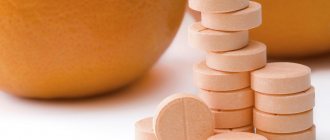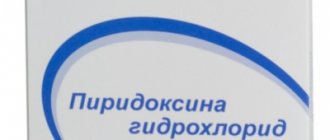© Bildgigant — stock.adobe.com
Share:
We all know about the existence of vitamin B12, but few people are aware that the line of vitamins in this group has continued, and there is an element called B13. It cannot be unambiguously classified as a complete vitamin, but, nevertheless, it has properties that are important for the body.
Characteristics
Although the word “vitamin” has taken root for this acid, it is a vitamin-like substance.
Properties of vitamin B13:
- these are crystals that have no color;
- practically insoluble in water and other liquids;
- are destroyed when exposed to light.
This vitamin appears as a result of the biosynthesis of nucleotides as an intermediate product. It can be found in the cells of living organisms.
Microorganisms living in symbiosis with our intestines are capable of synthesizing B13. In particular, for this reason it cannot be completely classified as a vitamin.
The importance of vitamin B13 for the human body
Let's look at what orotic acid affects:
- Exchange processes. The vitamin-like compound is involved in the synthesis of pyrimidine nucleotides in the liver. The beneficial effect of the substance on enzyme activity, nitrogen metabolism and protein translation is explained by its participation in the metabolism of nucleic acids. In addition, vitamin B13 is associated with the synthesis of lecithin, phospholipids, bilirubin, and stimulates the production of enzymes for carbohydrate metabolism.
- The process of growth. As a result of experiments on animals, scientists came to the conclusion that the compound enhances cell growth. The lack of animal protein factor (as orotic acid was originally called) in the diet of experimental animals led to the fact that females began to produce inferior offspring, especially the second generation. The young individuals that were born grew poorly and died en masse, particularly during lactation. Adding vitamin B13 to the daily menu helped normalize the growth of animals, as well as increase the survival rate of offspring.
- Enzyme activity. In order to determine the relationship between uracil-carboxylic acid and cyanocobalamin, an experiment was conducted on rats at the end of the 20th century, which showed that with B12 deficiency, the enzymatic activity of the liver decreases (glucose-6-phosphatase, cytochrome oxidase, transmethylase, xanthine oxidase) and cell growth is significantly reduced . And when the vitamin enters the experimental subjects’ body, the production of protein molecules is normalized. In the process of studying orotic acid, it turned out that it enhances the enzyme activity of amino acids. Thus, in rats on a diet high in galactose, the production of organic compounds decreased by more than 2 times.
- Pathological condition of the liver. As a result of numerous studies, the Schwietzer scientist found that the vitamin-like substance B13 inhibits the development of toxic gland disease, the clinical picture of which resembles cirrhosis. The progression of the disease is due to heliotropin and thioacetamide. When orotic acid is administered, the amount of purines in the body increases, which facilitates the process of building nucleic acids. In addition, the compound slows down fatty infiltration of the liver, enhances bile secretion and accelerates the process of hepatocyte regeneration.
- Radiation intoxication. To determine how vitamin B13 affects living organisms, a group of scientists conducted an experiment on animals. The experimental animals were divided into 2 categories. For 10 days, the potassium salt of uracil-4-carboxylic acid was introduced into the diet of the first group at the rate of 100 milligrams of the substance per kilogram of body weight, the second did not receive this nutrient and served as a control group. After completion of the experiment, the animals were subjected to intense irradiation (2000 gray). In the group that consumed the compound, survival was 119 hours, in the control group it was 4 hours 20 minutes. Thus, regular use of orotic acid during radiation intoxication in prophylactic doses extended the life of the experimental subjects by 16 days. The results of the experiment indicate that the vitamin-like substance can be used as a protective agent against ionizing radiation.
In addition to the indicated properties, uracil-4-carboxylic acid performs the following functions in the human body:
- prevents narrowing of the lumen of blood vessels due to the appearance of atherosclerotic plaques and, as a consequence, the development of atherosclerosis;
- participates in the metabolic processes of proteins and phospholipids;
- participates in the metabolism of cyanocobalamin (vitamin B12), folic and pantothenic acids;
- participates in the synthesis and maintenance of adenosine triphosphate reserves, in the synthesis of the amino acid methionine and glucose utilization;
- promotes the proper course of anabolic processes, stimulates muscle growth (ribonucleic acid synthesis) and activates the contractile capabilities of muscle tissue;
- improves myocardial contraction;
- stimulates reproductive function.
The main effect of orotic acid is to participate in the synthesis of the constituent particles of DNA and RNA - pyrimidine nucleotides.
Role in health
Now we know that this substance is found in all our cells, so it’s worth finding out why the body needs vitamin B13.
- The element takes part in the synthesis of phospholipids. These are complex lipids created from a phosphoric acid residue and various additional groups. These substances are found in cell membranes.
- B13 is involved in the production of nucleic acids, which ensures proper human growth. This occurs both due to the effect on cells individually, and due to the effect on the entire body.
- The following substances produced with the participation of orotic acid are blood cells. These include leukocytes and erythrocytes. By participating in this process, B13 improves hematopoiesis and is considered a remedy for anemia, especially if it occurs as a result of radiation exposure.
- The vitamin has an anabolic effect. We often hear words like “anabolic”, but what do they mean? In short, the anabolic effect is an improvement in protein synthesis, which, among other things, leads to an increase in muscle mass. It is not surprising that anabolic drugs always mean steroid drugs. The point of steroids is that they give our body certain hormones, instead of allowing the body to produce them on its own. However, orotic acid is not a steroid and is not a hormone, but it helps our muscles grow and develop. Yes, this happens much more slowly than if we decided to take steroids, but there are much fewer negative consequences from this.
- B13 has a beneficial effect on the formation and development of the fetus in expectant mothers.
- As a result of metabolic disorders, the liver is often damaged. It can also occur due to exposure to toxins, radiation, poor diet and gastrointestinal diseases. When the liver is damaged, it responds by causing excess fat to accumulate in its supporting tissues. This process is called fatty degeneration. Orotic acid helps protect against this and also restore liver cells.
- This member of group B reduces the amount of cholesterol present, which helps prevent the formation of plaque in the arteries.
- The vitamin reduces the likelihood of premature aging and fights the later stages of sclerosis.
- Utilizes glucose and participates in the production of ribose.
- Promotes the synthesis of muscle carnosine, a substance with antioxidant properties.
Orotic acid in medicine
The benefits of orotic acid were first proven in the early 20th century. Today it is actively used not only in cosmetology, but also in medicine. There are real cases in history when the drug helped children aged 6-12 months with skin diseases: ichthyosis, eczema, psoriasis, neurodermatitis. The medical form of the substance is Potassium Orotate - tablets and Magnesium Orotate - powder.
Indications for taking the drug:
- Liver diseases.
- Orotic acid is used to treat leg cramps.
- Botkin's disease.
- Heart failure.
- Postoperative period.
- Diseases of the stomach, gastrointestinal tract.
- Viral hepatitis.
With the help of orotic acid, the body better tolerates taking medications: resoquine, steroid hormones, antibiotics, delagil, sulfonamide.
Orotic acid is effective against gout - numerous inflammatory processes in joint and kidney tissues. In case of illness, it stimulates protein metabolism, protects internal organs from toxic substances, and relieves pain. Metabolic effects occur against the background of the disease. This occurs due to the excretion of uric acid compounds by the kidneys. Orotic acid accelerates the elimination of toxic breakdown products and limits the concentration of urea in the bloodstream.
In addition to their benefits, substances can cause harm to the human body. Contraindications, precautions:
- Nephrourolithiasis.
- Kidney failure.
- Allergy.
- Acute liver lesions complicated by ascites.
- Hypersensitivity
If there are prerequisites for the above diseases, you should refrain from taking the drug so as not to harm your health.
Advice! It is recommended to consult a doctor before taking the drug.
Use for diseases
Indications for the use of vitamin B13 are their use as a component of complex treatment of various pathologies. Among them:
- angina pectoris
- myocardial infarction,
- heart rhythm problems,
- heart failure,
- dermatosis,
- hepatitis,
- hepatosis,
- atherosclerosis,
- biliary tract diseases,
- childhood dystrophy,
- myocardial dystrophy,
- muscular dystrophy,
- disorder of motor activity of organs,
- hyperlipidemia,
- anemia.
Contraindications and side effects
Do not prescribe for hypersensitivity to the substance, organic liver damage (including cirrhosis) and renal failure. The instructions for use of orotic acid indicate that during breastfeeding and pregnancy they should be used with caution and strictly for medical reasons.
Possible side effects: nausea, vomiting, unstable stool, dermatoses. Does not impair reaction speed and does not cause drowsiness.
At a high dosage on the background of a diet low in proteins, it can provoke liver dystrophy.
Required amount
As with all similar substances, the daily requirement of vitamin B13 varies from person to person. The dosage is affected by the person's age, health, and level of physical activity. With intense training, especially among athletes, the daily required amount of this vitamin increases greatly. The same applies to people suffering from serious illnesses or undergoing operations.
It is believed that the norm for adults is up to two grams of the substance. Expectant mothers can increase the dosage to three grams, as can breastfeeding women. The children's amount is up to 1.5 g, and infants should not take more than the minimum amount for adults, that is, no more than 0.5 g.
Beneficial features
Orotic acid is essential for building the DNA building blocks of all cells; it is also involved in energy metabolism, stimulating the use of glucose and converting it into energy.
The vitamin performs important functions:
● participates in the formation of germ cells, protects them from damage; ● reduces the risks of cardiovascular pathologies; ● improves energy exchange, load tolerance; ● stimulates muscle activity; ● improves blood lipid spectrum; ● protects against peroxidation; ● promotes cell reproduction, slowing down aging. The vitamin also has a beneficial effect on the skin, significantly improving its appearance.
Insufficient and excessive consumption
Vitamin B13 deficiency is a rare and mild phenomenon. This is due, first of all, to the fact that our body is able to produce a certain amount of this vitamin. In addition to this, other representatives of group B are able to take the place of the thirteenth if necessary, thereby protecting the body from deficiency.
In this regard, insufficient intake of the substance does not lead to any specific diseases. Studies report only cases of worsening of skin diseases.
An overdose of vitamin B13 can occur due to uncontrolled use of medications. As a result, allergies appear in the form of redness and itching, and problems with the gastrointestinal tract may also appear. Stopping the use of medications will quickly return the body to normal.
If the overdose of orotic acid was too powerful, disturbances in the functioning of the liver and stomach are possible.
Indications for use
A medicinal product based on orotic acid is “Potassium Orotate”. This medicine is used:
- For stomach and duodenal ulcers;
- Heart failure;
- Rehabilitation in the postoperative period;
- Prolonged physical fatigue.
Interaction
Orotic acid is used for better absorption of a number of therapeutic agents: hormones, sulfonamides, antibiotics. Helps convert pantothenic and folic acids, cyanocobalamin. The results of consuming vitamin B13 are enhanced by combined use of medications with magnesium. Where orotic acid is contained, the toxicity of commonly used cardiac glycosides is reduced.
Prescribed astringent and enveloping drugs impair the body's absorption of this vitamin. If there is a deficiency of vitamin B12 in the diet, orotic acid supplied with food can partially compensate for the lack of this substance, ensuring the correct course of many enzymatic reactions.
Sources of acid
Let's look at where vitamin B13 is found.
It is unlikely that you will be able to find orotic acid in foods in its pure form. But various salts are found quite often - including calcium, potassium and magnesium. After they enter the blood during absorption, they turn into orotic acid.
What foods contain vitamin B13:
- among animal products, acid can be obtained from liver and dairy foods, including horse milk, cheese, curdled milk and kefir;
- Among plant foods, the content of the required substance differs primarily in yeast, as well as root vegetables;
- Infants can easily obtain this vitamin from their mother's breast milk.
Interestingly, unlike the vast majority of any other vitamins, B13 will remain in food, regardless of the power of heat treatment.
Content in food
Vitamin B13 can be synthesized in the intestines, supplemented by the amount that comes with food.
© alfaolga — stock.adobe.com
| Products* | Vitamin B13 content (g) |
| Brewer's yeast | 1,1 – 1,6 |
| Animal liver | 1,6 – 2,1 |
| Sheep milk | 0,3 |
| Cow's milk | 0,1 |
| Natural fermented milk products; | Less than 0.08 g |
| Beetroot and carrots | Less than 0.8 |
*Source – Wikipedia
Vitamin and other substances
If the body is adequately saturated with vitamin B13, then the process of absorption of folic acid occurs much better. You can read more about vitamin B9 here.
If for certain reasons there is a deficiency of vitamin B12 in the human body, then orotic acid will try to replace it. However, it is, of course, better not to allow this to happen. To do this, you need to study cyanocobalamin (aka B12). It is also worth considering taking the “Healthy Eating” course, which will allow you to normalize your diet and not worry about deficiencies of various vitamins.
Sometimes this acid can alleviate the condition of the body when taking antibiotics.
Signs of excess
Allergies in the form of extensive rashes on the skin. Minor disturbances in digestion: flatulence, lightheadedness, vomiting, diarrhea. When taking the drug "Potassium Orotate" on a low-protein diet, there is a risk of liver dystrophy. Excessive influx in the body was noted only with uncontrolled use of medications with vitamin B13. In such a situation, an allergy may appear, manifested by redness of the skin and itching. In addition, gastrointestinal upset may also begin. In addition, an excessive amount of this element will lead to liver failure or dyspepsia. With the cessation of the use of these drugs, all signs of its excess disappear relatively quickly.
General information
Vitamin B13 is a vitamin-like substance that is a precursor of nucleic acids and a component of all living cells.
The chemical name is orotic acid. In the human body, it is synthesized in sufficient quantities by intestinal microflora and is also supplied with food. The importance of this compound is evidenced by the fact that it makes up the bulk (up to 90% of whey proteins) of a woman’s milk in the first 3-5 days after birth. Calcium, potassium and magnesium salts or orotic acid monohydrate are used as therapeutic agents. The absorption of drugs is very weak. About 10% of the dose taken is absorbed, of which 30% is excreted in the urine in the form of various metabolites.
Orotic acid has pronounced acidic properties and is highly soluble in alkalis; bad - in boiling water and organic solvents; does not dissolve in cold water and acids. It is destroyed under the influence of ultraviolet rays and very high temperatures (345 degrees), and easily forms salts with metals.
Vitamin B13 was discovered by Italian pharmacists Giuseppe Biscaro and Ernesto Belloni in 1904. During the production of lactose in its crystals, they discovered a new substance, which turned out to be the potassium salt of a previously unknown acid. The compound was given the name orotic acid (from the Greek oros - whey). In 1905, it was first isolated from cow's milk, and later found in the milk of other animals and humans.
In 1930, German chemist Marcel Bachstitz described the chemical structure of orotic acid. It turned out that it is part of the growth factor DDS, found in wine production waste and called vitamin B13. On this basis, the acid was called vitamin B14. However, later, when all the components of the growth factor were discovered, orotic acid was given the name vitamin B13.











